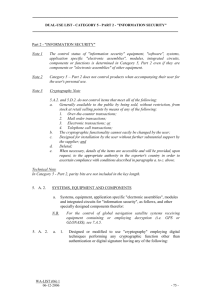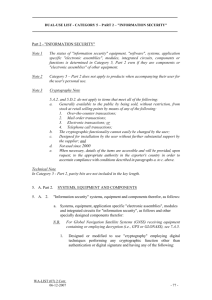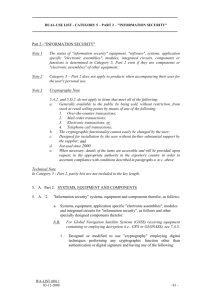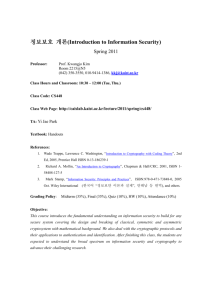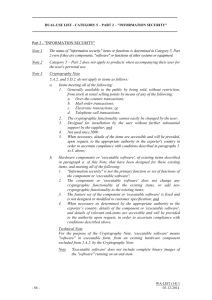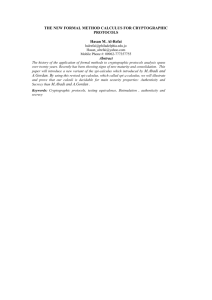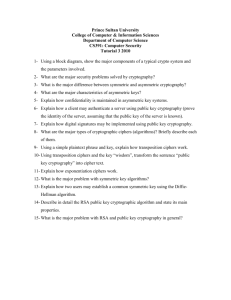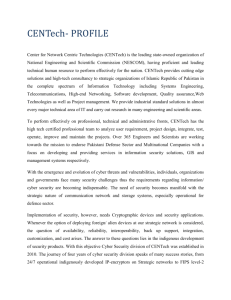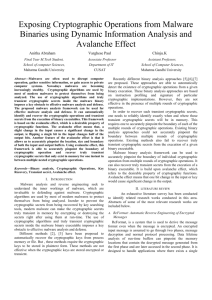DUAL-USE LIST - CATEGORY 5 – PART 2 – "INFORMATION
advertisement
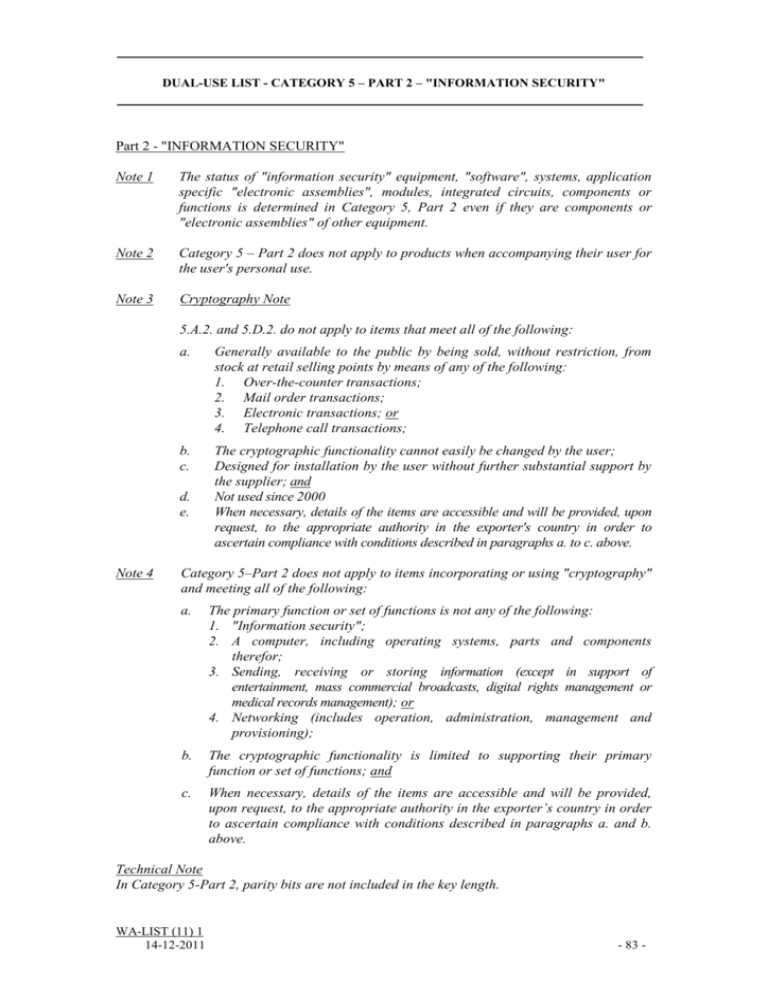
____________________________________________________________________ DUAL-USE LIST - CATEGORY 5 – PART 2 – "INFORMATION SECURITY" ____________________________________________________________________ Part 2 - "INFORMATION SECURITY" Note 1 The status of "information security" equipment, "software", systems, application specific "electronic assemblies", modules, integrated circuits, components or functions is determined in Category 5, Part 2 even if they are components or "electronic assemblies" of other equipment. Note 2 Category 5 – Part 2 does not apply to products when accompanying their user for the user's personal use. Note 3 Cryptography Note 5.A.2. and 5.D.2. do not apply to items that meet all of the following: a. Generally available to the public by being sold, without restriction, from stock at retail selling points by means of any of the following: 1. Over-the-counter transactions; 2. Mail order transactions; 3. Electronic transactions; or 4. Telephone call transactions; b. c. The cryptographic functionality cannot easily be changed by the user; Designed for installation by the user without further substantial support by the supplier; and Not used since 2000 When necessary, details of the items are accessible and will be provided, upon request, to the appropriate authority in the exporter's country in order to ascertain compliance with conditions described in paragraphs a. to c. above. d. e. Note 4 Category 5–Part 2 does not apply to items incorporating or using "cryptography" and meeting all of the following: a. The primary function or set of functions is not any of the following: 1. "Information security"; 2. A computer, including operating systems, parts and components therefor; 3. Sending, receiving or storing information (except in support of entertainment, mass commercial broadcasts, digital rights management or medical records management); or 4. Networking (includes operation, administration, management and provisioning); b. The cryptographic functionality is limited to supporting their primary function or set of functions; and c. When necessary, details of the items are accessible and will be provided, upon request, to the appropriate authority in the exporter’s country in order to ascertain compliance with conditions described in paragraphs a. and b. above. Technical Note In Category 5-Part 2, parity bits are not included in the key length. WA-LIST (11) 1 14-12-2011 - 83 - ____________________________________________________________________ DUAL-USE LIST - CATEGORY 5 – PART 2 – "INFORMATION SECURITY" ____________________________________________________________________ 5. A. Part 2. SYSTEMS, EQUIPMENT AND COMPONENTS 5. A. 2. "Information security" systems, equipment and components therefor, as follows: a. Systems, equipment, application specific "electronic assemblies", modules and integrated circuits for "information security", as follows, and components therefor specially designed for "information security": N.B. 5. A. 2. a. 1. For Global Navigation Satellite Systems (GNSS) receiving equipment containing or employing decryption, see 7.A.5. Designed or modified to use "cryptography" employing digital techniques performing any cryptographic function other than authentication or digital signature and having any of the following: Technical Notes 1. Authentication and digital signature functions include their associated key management function. 2. Authentication includes all aspects of access control where there is no encryption of files or text except as directly related to the protection of passwords, Personal Identification Numbers (PINs) or similar data to prevent unauthorised access. 3. "Cryptography" does not include "fixed" data compression or coding techniques. Note 5. A. 2. 5. A. 2. - 84 - a. a. 1. 5.A.2.a.1. includes equipment designed or modified to use "cryptography" employing analogue principles when implemented with digital techniques. a. A "symmetric algorithm" employing a key length in excess of 56 bits; or b. An "asymmetric algorithm" where the security of the algorithm is based on any of the following: 1. Factorisation of integers in excess of 512 bits (e.g., RSA); 2. Computation of discrete logarithms in a multiplicative group of a finite field of size greater than 512 bits (e.g., DiffieHellman over Z/pZ); or 3. Discrete logarithms in a group other than mentioned in 5.A.2.a.1.b.2. in excess of 112 bits (e.g., Diffie-Hellman over an elliptic curve); 2. Designed or modified to perform cryptanalytic functions; 3. Not used since 1998 4. Specially designed or modified to reduce the compromising emanations of information-bearing signals beyond what is necessary for health, safety or electromagnetic interference standards; 5. Designed or modified to use cryptographic techniques to generate the spreading code for "spread spectrum" systems, not specified by 5.A.2.a.6., including the hopping code for "frequency hopping" systems; WA-LIST (11) 1 14-12-2011 ____________________________________________________________________ DUAL-USE LIST - CATEGORY 5 – PART 2 – "INFORMATION SECURITY" ____________________________________________________________________ 5. A. 2. a. 6. Designed or modified to use cryptographic techniques to generate channelizing codes, scrambling codes or network identification codes, for systems using ultra-wideband modulation techniques and having any of the following: a. A bandwidth exceeding 500MHz; or b. A "fractional bandwidth" of 20% or more; 7. Non-cryptographic information and communications technology (ICT) security systems and devices evaluated to an assurance level exceeding class EAL-6 (evaluation assurance level) of the Common Criteria (CC) or equivalent; 8. Communications cable systems designed or modified using mechanical, electrical or electronic means to detect surreptitious intrusion; Note 5.A.2.a.8. applies only to physical layer security. 9. 5. A. 2. Designed or modified to use "quantum cryptography". Technical Note "Quantum cryptography" is also known as Quantum Key Distribution (QKD). b. Systems, equipment, application specific "electronic assemblies", modules and integrated circuits, designed or modified to enable an item to achieve or exceed the controlled performance levels for functionality specified by 5.A.2.a. that would not otherwise be enabled. Note WA-LIST (11) 1 14-12-2011 5.A.2. does not apply to any of the following: a. Smart cards and smart card 'readers/writers' as follows: 1. A smart card or an electronically readable personal document (e.g., token coin, e-passport) that meets any of the following: a. The cryptographic capability is restricted for use in equipment or systems excluded from 5.A.2. by Note 4 in Category 5–Part 2 or entries b. to i. of this Note, and cannot be reprogrammed for any other use; or b. Having all of the following: 1. It is specially designed and limited to allow protection of 'personal data' stored within; 2. Has been, or can only be, personalized for public or commercial transactions or individual identification; and 3. Where the cryptographic capability is not useraccessible; Technical Note 'Personal data' includes any data specific to a particular person or entity, such as the amount of money stored and data necessary for authentication. - 85 - ____________________________________________________________________ DUAL-USE LIST - CATEGORY 5 – PART 2 – "INFORMATION SECURITY" ____________________________________________________________________ 5. A. 2. Note a. cont. 2. b. c. d. e. f. 'Readers/writers' specially designed or modified, and limited, for items specified by a.1. of this Note; Technical Note 'Readers/writers' include equipment that communicates with smart cards or electronically readable documents through a network. Not used since 2009 N.B. See Note 4 in Category 5-Part 2 for items previously specified in 5.A.2. Note b. Not used since 2009 N.B. See Note 4 in Category 5-Part 2 for items previously specified in 5.A.2. Note c. Cryptographic equipment specially designed and limited for banking use or 'money transactions'; Technical Note 'Money transactions' in 5.A.2. Note d. includes the collection and settlement of fares or credit functions. Portable or mobile radiotelephones for civil use (e.g., for use with commercial civil cellular radio communication systems) that are not capable of transmitting encrypted data directly to another radiotelephone or equipment (other than Radio Access Network (RAN) equipment), nor of passing encrypted data through RAN equipment (e.g., Radio Network Controller (RNC) or Base Station Controller (BSC)); Cordless telephone equipment not capable of end-to-end encryption where the maximum effective range of unboosted cordless operation (i.e., a single, unrelayed hop between terminal and home base station) is less than 400 metres according to the manufacturer's specifications; g. Portable or mobile radiotelephones and similar client wireless devices for civil use, that implement only published or commercial cryptographic standards (except for anti-piracy functions, which may be non-published) and also meet the provisions of paragraphs b. to e. of the Cryptography Note (Note 3 in Category 5, Part 2), that have been customised for a specific civil industry application with features that do not affect the cryptographic functionality of these original non-customised devices; h. Not used since 2009 N.B. See Note 4 in Category 5-Part 2 for items previously specified in 5.A.2. Note h. i. - 86 - Wireless "personal area network" equipment that implement only published or commercial cryptographic standards and where the cryptographic capability is limited to a nominal operating range not exceeding 30 metres according to the manufacturer’s specifications; or WA-LIST (11) 1 14-12-2011 ____________________________________________________________________ DUAL-USE LIST - CATEGORY 5 – PART 2 – "INFORMATION SECURITY" ____________________________________________________________________ 5. A. 2. Note cont. j. Equipment, having no functionality specified by 5.A.2.a.2., 5.A.2.a.4., 5.A.2.a.7., or 5.A.2.a.8., where all cryptographic capability specified by 5.A.2.a. meets any of the following: 1. It cannot be used; or 2. It can only be made useable by means of ″cryptographic activation″. N.B. See 5.A.2.a. for equipment that has undergone ″cryptographic activation″. 5. B. Part 2. TEST, INSPECTION AND PRODUCTION EQUIPMENT 5. B. 2. "Information security" test, inspection and "production" equipment, as follows: a. b. Equipment specially designed for the "development" or "production" of equipment specified by 5.A.2. or 5.B.2.b.; Measuring equipment specially designed to evaluate and validate the "information security" functions of equipment specified by 5.A.2. or "software" specified by 5.D.2.a. or 5.D.2.c. 5. C. Part 2. MATERIALS - None 5. D. Part 2. SOFTWARE 5. D. 2. "Software" as follows: a. b. c. d. WA-LIST (11) 1 14-12-2011 "Software" specially designed or modified for the "development", "production" or "use" of equipment specified by 5.A.2. or "software" specified by 5.D.2.c.; "Software" specially designed or modified to support "technology" specified by 5.E.2.; Specific "software" as follows: 1. "Software" having the characteristics, or performing or simulating the functions of the equipment, specified by 5.A.2.; 2. "Software" to certify "software" specified by 5.D.2.c.1. "Software" designed or modified to enable an item to achieve or exceed the controlled performance levels for functionality specified by 5.A.2.a. that would not otherwise be enabled. - 87 - ____________________________________________________________________ DUAL-USE LIST - CATEGORY 5 – PART 2 – "INFORMATION SECURITY" ____________________________________________________________________ 5. E. Part 2. TECHNOLOGY 5. E. 2. - 88 - "Technology" as follows: a. "Technology" according to the General Technology Note for the "development", "production" or "use" of equipment specified by 5.A.2. or 5.B.2. or "software" specified by 5.D.2.a. or 5.D.2.c.; b. "Technology" to enable an item to achieve or exceed the controlled performance levels for functionality specified by 5.A.2.a. that would not otherwise be enabled. WA-LIST (11) 1 14-12-2011
